THE HEBRA THAT BROKE” The untold story in the collective memory of Chi Metztli women through their embroidery in Arroyo Cumiapa San Luis Acatlán Guerrero
DOI:
https://doi.org/10.56294/piii2024.149Keywords:
Globalization, Gender Violence, InequalityAbstract
Violence against women has its roots in culture and in the way it is socially structured, where the exclusion of women is evident through unequal opportunities and the sexual division of labor.
Although it is true that the different ways of being a woman in the indigenous world are shaped by the particular gender constructions of the peoples to which they belong, it is important to identify the influence that globalization imposes on them in this context, since it has brought about “the feminization of poverty”.
Immersed in this multi-violence, they have endured in silence the crises of a world that has excluded them and then forgotten them. Their art, based on stitches and colors, has changed after the onslaught of the pandemic, natural, economic and cultural crises that are shaking the world; the production of their textile arts has taken a back seat in this technological and rapacious era. Their embroidered stories, their ancestral materials no longer make sense to the new generations, and if that were not enough, on top of all this, the powers that be have invaded their territories, their plots of land, effectively silencing their voices when it comes to embroidery. Because there are stories that they simply do not wish to remember. Their commissioned work tells an imaginary story that is told to them and imposed on them by someone else, totally alien to their cosmogony and locality.
References
Almond, G. A., & Verba, S. (1965). Un enfoque sobre la cultura política. En G. A
Almond, & S. Vebra, La Cultura Civica (págs. 171-201). Coleccion FF Serie Estudios.
Amorós, C. (1991). Hacía una crítica de la razón patriarcal. Barcelona: ANTHROPOS.
Bauman, Z. (2004). Vidas desperdiciadas, la modernidad y sus parias. En Z. Bauman, Vidas desperdiciadas, la modernidad y sus parias (págs. 21-84). Paidós.
Bauman, Z., & Bordoni, C. (2016). Estado de Crisis. Paidós.
Blazquez Graf, N. (2012). Epistemología Feminista: Temas centrales. En N. Blazquez Graf, Investigación feminista: Epistemología, Metodología y Representaciones sociales (págs. 21-38). México, D.F.: UNAM, Centro de Investigaciones Interdisciplinarias en Ciencias y Humanidades.
Blisniewsky, T. (2009). Mujeres que no pierden el hilo. Madrid, España: MAEVA.
Boaventura De Sousa, S. (2020). La cruel pedagogía del virus. CLACSO.
Boleaga O, P. I. (13 de MAYO de 2021). ENTRE BORDAR O MORIR. Historia de vida de la familia Ndyob’a en Arroyo Cumiapa San Luis Acatlán Guerrero. CHILPANCINGO, GUERRERO, MEXICO.
Cantoral, R. (2013). Teoría socioepistemológica de la Matemática Educativa. Estudios sobre construcción social del conocimiento. Barcelona, España: GANDIA.
Chomsky, N. (2006). Language and Mind. Cambridge University Press. https://doi.org/file:///C:/Users/Admin/Desktop/doctorado%20protocolo/TEORIA%20POLITICA%20II%20DR%20%20MARCO%20ANTONIO%20MORALES%20TEJEDA/Language%20and%20Mind.pdf DOI: https://doi.org/10.1017/CBO9780511791222
Floriano Cumbreño, A. (2015). El Bordado. Madrid, España: ALBERTO MARTIN.
Gramcsi, A. (1985). Cuadernos de la Carcel. Italia: ediciones ERA.
Instituto Nacional de Estadistica y Censos Republica Argentina, I. (2010). Censo Nacional de Población, Hogares y Viviendas 2010, Censo del Bicentenario. República Argentina.: UBA Sociales. Facultad de Ciencias Sociales/ INDEC.
Kubli-Garcia, F. (2006). Pasado, presente y futuro de los derechos indígenas en México. UNAM. https://doi.org/https://archivos.juridicas.unam.mx/www/bjv/libros/4/1855/19.pdf
Maquiavelo, N. (1999). El Principe. Buenos Aires Argentina: ElAleph.
Marcuse, H. (1993). EL HOMBRE UNIDIMENSIONAL. ENSAYO SOBRE LA IDEOLOGIA DE LA SOCIEDAD INDUSTRIAL AVANZADA. Editorial Planeta.
Mato Turner, C. (1993). Aves sin nido. Fundación Bibliioteca Ayacucho.
Morín, E. (2011). ¿Hacía dónde va el mundo? Paidós.
Olalde Rico, K. (2020). Bordando por la paz y la memoria en México: feminidad sin sumisión y aspiraciones democráticas. Debate Feminista, 58, 1-30. https://doi.org/https://doi.org/10.22201/cieg.2594066xe.2019.58.01 DOI: https://doi.org/10.22201/cieg.2594066xe.2019.58.01
Parker, R. (1996). The Subversive Stitch Embroidery and the Making of the femenine. . THE WOMEN´S PRESS.
Parker, R. (2010). The Subversive Stitch: bordado y la fabricación de la femenina. I.B. TAURIS.
Pérez-Bustos, T. (2016). El tejido como conocimiento, el conocimiento como tejido: reflexiones feministas en torno a la agencia de las materialidades. Rev. Colomb. Soc., 163-182. DOI: https://doi.org/10.15446/rcs.v39n2.58970
Ramírez, S. (27 de marzo de 2023). International Work Group for Indigenous Affairs. iwgia.org: https://www.iwgia.org/es/argentina/5075-mi-2023-argentina.html
Re.Te.C.I., A. d. (Noviembre de 2022). Instituto Nacional de Asuntos Indígenas. https://www.argentina.gob.ar/derechoshumanos/inai: https://www.argentina.gob.ar/derechoshumanos/inai
Rodriguez, F. (2004). La pobreza como un proceso de violencia estructural. Revista de Ciencias Sociales (RCS), X(1), 1-9. https://doi.org/https://www.flacsoandes.edu.ec/sites/default/files/agora/files/1278089538.francisco_rodriguez.pdf
Russo Foresto, J. (2021). Populismo y situación radical. En J. L. Estrada Rodriguez, A. C. Gómez Rojas, C. A. Galviz Ortiz, C. Cattafi, G. Córdova, H. Sanchez Gudiño, . . . Y. Takahashi, DEMOCRACIA LATINOAMERICANA ¿HACIA DÓNDE VAMOS? (págs. 31-50). Thoth.
Sartori, G. (1998). Homo videns La sociedad teledirigida. Taurus. https://doi.org/file:///C:/Users/Admin/Desktop/doctorado%20protocolo/TEORIA%20POLITICA%20II%20DR%20%20MARCO%20ANTONIO%20MORALES%20TEJEDA/Homo-Videns.pdf
Segato, R. L. (2003). Las Estructuras elementales de la violencia. Buenos Aires, Argentina: UNIVERSIDAD NACIONAL DE QUILMES.
Viveros Vigoya, M. (2016). La interseccionalidad: Una aproximación situada a la dominación. DEBATE FEMINISTA, 2-17. DOI: https://doi.org/10.1016/j.df.2016.09.005
Downloads
Published
Issue
Section
License
Copyright (c) 2024 Paola Isabel Boleaga Ocampo (Author)

This work is licensed under a Creative Commons Attribution 4.0 International License.
The article is distributed under the Creative Commons Attribution 4.0 License. Unless otherwise stated, associated published material is distributed under the same licence.





